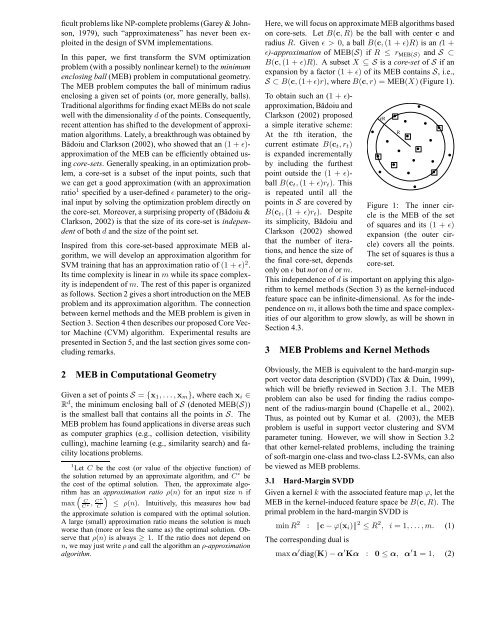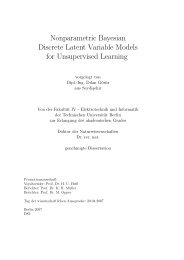Very Large SVM Training using Core Vector Machines
Very Large SVM Training using Core Vector Machines
Very Large SVM Training using Core Vector Machines
You also want an ePaper? Increase the reach of your titles
YUMPU automatically turns print PDFs into web optimized ePapers that Google loves.
ficult problems like NP-complete problems (Garey & Johnson,<br />
1979), such “approximateness” has never been exploited<br />
in the design of <strong>SVM</strong> implementations.<br />
In this paper, we first transform the <strong>SVM</strong> optimization<br />
problem (with a possibly nonlinear kernel) to the minimum<br />
enclosing ball (MEB) problem in computational geometry.<br />
The MEB problem computes the ball of minimum radius<br />
enclosing a given set of points (or, more generally, balls).<br />
Traditional algorithms for finding exact MEBs do not scale<br />
well with the dimensionality d of the points. Consequently,<br />
recent attention has shifted to the development of approximation<br />
algorithms. Lately, a breakthrough was obtained by<br />
Bădoiu and Clarkson (2002), who showed that an (1 + ǫ)approximation<br />
of the MEB can be efficiently obtained <strong>using</strong><br />
core-sets. Generally speaking, in an optimization problem,<br />
a core-set is a subset of the input points, such that<br />
we can get a good approximation (with an approximation<br />
ratio 1 specified by a user-defined ǫ parameter) to the original<br />
input by solving the optimization problem directly on<br />
the core-set. Moreover, a surprising property of (Bădoiu &<br />
Clarkson, 2002) is that the size of its core-set is independent<br />
of both d and the size of the point set.<br />
Inspired from this core-set-based approximate MEB algorithm,<br />
we will develop an approximation algorithm for<br />
<strong>SVM</strong> training that has an approximation ratio of (1 + ǫ) 2 .<br />
Its time complexity is linear in m while its space complexity<br />
is independent of m. The rest of this paper is organized<br />
as follows. Section 2 gives a short introduction on the MEB<br />
problem and its approximation algorithm. The connection<br />
between kernel methods and the MEB problem is given in<br />
Section 3. Section 4 then describes our proposed <strong>Core</strong> <strong>Vector</strong><br />
Machine (CVM) algorithm. Experimental results are<br />
presented in Section 5, and the last section gives some concluding<br />
remarks.<br />
2 MEB in Computational Geometry<br />
Given a set of points S = {x1, . . .,xm}, where each xi ∈<br />
R d , the minimum enclosing ball of S (denoted MEB(S))<br />
is the smallest ball that contains all the points in S. The<br />
MEB problem has found applications in diverse areas such<br />
as computer graphics (e.g., collision detection, visibility<br />
culling), machine learning (e.g., similarity search) and facility<br />
locations problems.<br />
1 Let C be the cost (or value of the objective function) of<br />
the solution returned by an approximate algorithm, and C ∗ be<br />
the cost of the optimal solution. Then, the approximate algo-<br />
rithm<br />
“<br />
has an approximation ratio ρ(n) for an input size n if<br />
C<br />
max C∗ , C∗<br />
”<br />
≤ ρ(n). Intuitively, this measures how bad<br />
C<br />
the approximate solution is compared with the optimal solution.<br />
A large (small) approximation ratio means the solution is much<br />
worse than (more or less the same as) the optimal solution. Observe<br />
that ρ(n) is always ≥ 1. If the ratio does not depend on<br />
n, we may just write ρ and call the algorithm an ρ-approximation<br />
algorithm.<br />
Here, we will focus on approximate MEB algorithms based<br />
on core-sets. Let B(c, R) be the ball with center c and<br />
radius R. Given ǫ > 0, a ball B(c, (1 + ǫ)R) is an (1 +<br />
ǫ)-approximation of MEB(S) if R ≤ r MEB(S) and S ⊂<br />
B(c, (1 + ǫ)R). A subset X ⊆ S is a core-set of S if an<br />
expansion by a factor (1 + ǫ) of its MEB contains S, i.e.,<br />
S ⊂ B(c, (1+ǫ)r), where B(c, r) = MEB(X) (Figure 1).<br />
To obtain such an (1 + ǫ)approximation,<br />
Bădoiu and<br />
Clarkson (2002) proposed<br />
a simple iterative scheme:<br />
At the tth iteration, the<br />
current estimate B(ct, rt)<br />
is expanded incrementally<br />
by including the furthest<br />
point outside the (1 + ǫ)ball<br />
B(ct, (1 + ǫ)rt). This<br />
is repeated until all the<br />
points in S are covered by<br />
B(ct, (1 + ǫ)rt). Despite<br />
its simplicity, Bădoiu and<br />
Clarkson (2002) showed<br />
that the number of iterations,<br />
and hence the size of<br />
the final core-set, depends<br />
only on ǫ but not on d or m.<br />
εR<br />
R<br />
Figure 1: The inner circle<br />
is the MEB of the set<br />
of squares and its (1 + ǫ)<br />
expansion (the outer circle)<br />
covers all the points.<br />
The set of squares is thus a<br />
core-set.<br />
This independence of d is important on applying this algorithm<br />
to kernel methods (Section 3) as the kernel-induced<br />
feature space can be infinite-dimensional. As for the independence<br />
on m, it allows both the time and space complexities<br />
of our algorithm to grow slowly, as will be shown in<br />
Section 4.3.<br />
3 MEB Problems and Kernel Methods<br />
Obviously, the MEB is equivalent to the hard-margin support<br />
vector data description (SVDD) (Tax & Duin, 1999),<br />
which will be briefly reviewed in Section 3.1. The MEB<br />
problem can also be used for finding the radius component<br />
of the radius-margin bound (Chapelle et al., 2002).<br />
Thus, as pointed out by Kumar et al. (2003), the MEB<br />
problem is useful in support vector clustering and <strong>SVM</strong><br />
parameter tuning. However, we will show in Section 3.2<br />
that other kernel-related problems, including the training<br />
of soft-margin one-class and two-class L2-<strong>SVM</strong>s, can also<br />
be viewed as MEB problems.<br />
3.1 Hard-Margin SVDD<br />
Given a kernel k with the associated feature map ϕ, let the<br />
MEB in the kernel-induced feature space be B(c, R). The<br />
primal problem in the hard-margin SVDD is<br />
min R 2<br />
The corresponding dual is<br />
: c − ϕ(xi) 2 ≤ R 2 , i = 1, . . . , m. (1)<br />
max α ′ diag(K) − α ′ Kα : 0 ≤ α, α ′ 1 = 1, (2)

















